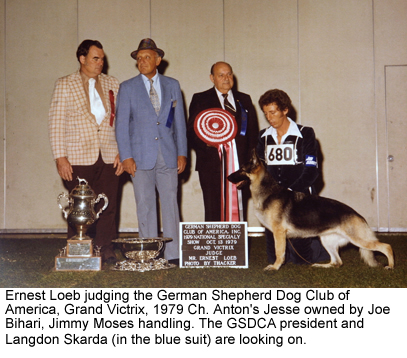A Passion to Survive: Story 1, Part II
By: Kerrin Winter-Churchill Date: 11/10/2006
 Long known in America as “Mr. German Shepherd”, noted AKC judge, Ernest Loeb was born in Germany to a Jewish Rottweiler breeder in 1910. As told to Gail Sprock, editor of the German Shepherd Review in an interview with Loeb, young Ernest fell for shepherds while training with his local all breed club. Soon Loeb was showing this breed, often under Captain Stephanitz, whom he greatly admired. As Loeb caught on to the dog game his reputation spread throughout the Motherland.
Long known in America as “Mr. German Shepherd”, noted AKC judge, Ernest Loeb was born in Germany to a Jewish Rottweiler breeder in 1910. As told to Gail Sprock, editor of the German Shepherd Review in an interview with Loeb, young Ernest fell for shepherds while training with his local all breed club. Soon Loeb was showing this breed, often under Captain Stephanitz, whom he greatly admired. As Loeb caught on to the dog game his reputation spread throughout the Motherland.
By 1934, Loeb had found his life’s passion but his world turned upside-down. Suddenly, he was banned from SV membership and customers, friends and neighbors were afraid to be seen talking to him. Sensing that life for a German Jew was getting worse, Loeb immigrated to New York. There he quickly found work and sent to Germany for his dogs.
In February 1935, Loeb entered his Brando von Heidelbeerberg in the Westminster Kennel Club Dog show. From eighty-seven entries, they took Best of Breed. This sky-rocketed the German-born Loeb’s fame. Americans began waving money at Loeb to import dogs for them. Traveling to Nazi Germany was dangerous but Loeb managed to get back and forth across the border many times beginning in 1936. Overlooking their own safety, Loeb’s German friends acted as scouts, finding quality dogs for importation. Occasionally stopped by the Gestapo, his friends would say, “don’t you know he’s the famous expert, Ernest Loeb?” Today, the win-at-all-cost, dog show exhibitor could learn a lot about humility and camaraderie from the Jewish Loeb and his German friends.
Modern American Shepherds
 From 1935 until 1960, Ernie imported over two-hundred German Shepherd Dogs of outstanding quality. Reading a list of the important dogs brought here by Loeb is akin to reading the Mayflower’s Passenger Manifest. Numerous American kennels began with Loeb imports. Topping this lofty list are Brando von Heidelbeerberg and Ch. Bernd vom Kallengarten ROM.
From 1935 until 1960, Ernie imported over two-hundred German Shepherd Dogs of outstanding quality. Reading a list of the important dogs brought here by Loeb is akin to reading the Mayflower’s Passenger Manifest. Numerous American kennels began with Loeb imports. Topping this lofty list are Brando von Heidelbeerberg and Ch. Bernd vom Kallengarten ROM.
Brando’s prominence is secured by the fact that he’s the fifth great grandsire of the immortal Can. Am. Grand Victor, Ch. Lance of Fran-Jo. Lance brought great beauty and balance to the breed. He is directly behind all the Great Ones of the last thirty years.
 Bernd vom Kallengarten came much later, during the fifties. While in Germany, Loeb learned of a magnificent dog in the French region of Germany. He bought the dog and drove toward the border where he noticed a sign restricting animal exportation. Quickly, Loeb convinced the young dog to lie quietly under a coat on the floor of the vehicle. The guards glanced into the car, saw nothing and motioned them through. From Bernd, the American dogs benefited from his marvelous pigment and ground-covering movement.
Bernd vom Kallengarten came much later, during the fifties. While in Germany, Loeb learned of a magnificent dog in the French region of Germany. He bought the dog and drove toward the border where he noticed a sign restricting animal exportation. Quickly, Loeb convinced the young dog to lie quietly under a coat on the floor of the vehicle. The guards glanced into the car, saw nothing and motioned them through. From Bernd, the American dogs benefited from his marvelous pigment and ground-covering movement.
Today, the magic potion of crossing the lines of Lance with those of Bernd is legendary. American fanciers owe a great debt to these two great dogs, and Ernest Loeb. Without them our world would never have know the immortal Manhattan, Mystic or the current Best in Show winning shepherd known as Dallas. Famed handler, James Moses has piloted all three of these legends to their outstanding careers. He pays great respect to Ernest Loeb. “I met Ernie when I was seventeen years old. At the time, he was showing for the top people in the country. Ernie taught me everything I know about the breed. How I look at them for structure, how they should move, conditioning them, how to present them. Ernie knew it all.”
Watching the magnificent flying trot of our best American dogs, one simply can’t help but be moved by their powerful beauty. This is an American phenomenon, courtesy of a daring young man who risked his life to become “Mr. German Shepherd”.

About The Author
All Authors Of This Article: | Kerrin Winter-Churchill |






